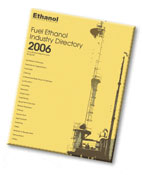 This is what my husband is doing out in San Diego – interviewing beautiful actresses. Daryl Hannah, star of “Splash” and other films, is a big biodiesel supporter and a regular attendee at the National Biodiesel Conference. Chuck interviewed both her and Charris Ford, founder of Grassolean Solutions. You can listen to the interview here
This is what my husband is doing out in San Diego – interviewing beautiful actresses. Daryl Hannah, star of “Splash” and other films, is a big biodiesel supporter and a regular attendee at the National Biodiesel Conference. Chuck interviewed both her and Charris Ford, founder of Grassolean Solutions. You can listen to the interview here
Great Cellulosic Ethanol Article
Here’s a very good, comprehensive report on cellulosic ethanol from Cox News Service. Good information about cellulosic, including blurbs about SunOpta’s new technology (see previous post) and Iogen’s progress in the field (also noted elsewhere on this blog). The article also points out the interest in cellulosic technology on the part of the Energy Future Coalition and Ted Turner. The conclusion is that a commercially feasible process for extracting ethanol from cellulose is still a breakthrough or two away, but lots of excitement building for this “new kind of ethanol.”
The article also notes that the Bush budget to be released tomorrow will ” include $150 million for research on cellulosic ethanol, a $59 million increase over the previous year.”
National Biodiesel Conference Kicks Off Today
 It’s Super Sunday in San Diego, where the National Biodiesel Conference is kicking off today. Catch all the action this week – play by play on the Biodiesel Conference blog starting today with the pre-game show – that is, the pre-conference sessions. Blogging pro Chuck Zimmerman got in to San Diego last night after spending the last four days in Denver blogging the Cattlemen’s Beef Board meeting. It has been a busy week for him! Someday he will be home again…
It’s Super Sunday in San Diego, where the National Biodiesel Conference is kicking off today. Catch all the action this week – play by play on the Biodiesel Conference blog starting today with the pre-game show – that is, the pre-conference sessions. Blogging pro Chuck Zimmerman got in to San Diego last night after spending the last four days in Denver blogging the Cattlemen’s Beef Board meeting. It has been a busy week for him! Someday he will be home again…
Anyway, you can check out the biodiesel conference blog for complete coverage – I will be providing highlights here on DomesticFuel. Have a super day!
Bio-Factoids
 Reuters has a little factiod list out about biofuels that has a few simple key points about ethanol and biodiesel in it and is very accurate. It’s really just Biofuels 101 and doesn’t touch on any judgements or opinions regarding energy efficiency or the like. More interesting to me than the Reuters fact list was the post about it on Autoblog, or I should say, the comments about the post. They showed a much greater lack of understanding and misinformation about biofuels than I would have expected from automaniacs. I hope that will change.
Reuters has a little factiod list out about biofuels that has a few simple key points about ethanol and biodiesel in it and is very accurate. It’s really just Biofuels 101 and doesn’t touch on any judgements or opinions regarding energy efficiency or the like. More interesting to me than the Reuters fact list was the post about it on Autoblog, or I should say, the comments about the post. They showed a much greater lack of understanding and misinformation about biofuels than I would have expected from automaniacs. I hope that will change.
I really loved the image on that Autoblog post – so much that I “borrowed” it to use here and want to give them full credit. Don’t know if it’s an Autoblog original, but I thought it was very cool. Nice job, whoever designed it.
The E-List
 If you are in the ethanol business as a supplier, producer, researcher, government agency, etc….the 2006 Fuel Ethanol Industry Directory wants to list you for free. The directory is being compiled by Ethanol Producer Magazine (a BBI Biofuels publication) and is distributed throughout the fuel ethanol industry at workshops, conferences and trade shows. The publication offers one free listing per organization and charges 40 bucks for each additional listing. Other pricing is available for display ads and logos. Deadline for listing is March 13.
If you are in the ethanol business as a supplier, producer, researcher, government agency, etc….the 2006 Fuel Ethanol Industry Directory wants to list you for free. The directory is being compiled by Ethanol Producer Magazine (a BBI Biofuels publication) and is distributed throughout the fuel ethanol industry at workshops, conferences and trade shows. The publication offers one free listing per organization and charges 40 bucks for each additional listing. Other pricing is available for display ads and logos. Deadline for listing is March 13.
Heard it Through the Pipeline
 Brazil is considering a pipeline for ethanol, according to an Associated Press report out today. The $226 million pipeline “would run from the central state of Goias to a refinery in Paulinia, near Sao Paulo, through Brazil’s main producing centers of sugar cane and ethanol,” and would be built by the government’s Petroleo Brasileiro SA, or Petrobras. Brazil is the world’s largest producer of ethanol and the country is getting heavily into the export market. The article quotes Petrobras Chief Executive Sergio Gabrielli saying Petrobras would be pioneering a new area of alternative fuel transportation. “We are the only country in the world that has the technology to build an ethanol pipeline,” Gabrielli said. “To make the ethanol market grow is strategic for the world, not only for Brazil.” While exports have been limited as the country has been concentrating on its domestic market, they are exporting to or in talks with exporting to Venezuela, Nigeria, China, South Korea, India and the United States. There is currently a 54-cent-a-gallon duty on imports of ethanol to the United States, which is intended to offset the federal tax subsidy for the U.S. industry. There are concerns that Brazil might challenge that tariff under the World Trade Organization. There was a good article on that subject recently in the Des Moines Register.
Brazil is considering a pipeline for ethanol, according to an Associated Press report out today. The $226 million pipeline “would run from the central state of Goias to a refinery in Paulinia, near Sao Paulo, through Brazil’s main producing centers of sugar cane and ethanol,” and would be built by the government’s Petroleo Brasileiro SA, or Petrobras. Brazil is the world’s largest producer of ethanol and the country is getting heavily into the export market. The article quotes Petrobras Chief Executive Sergio Gabrielli saying Petrobras would be pioneering a new area of alternative fuel transportation. “We are the only country in the world that has the technology to build an ethanol pipeline,” Gabrielli said. “To make the ethanol market grow is strategic for the world, not only for Brazil.” While exports have been limited as the country has been concentrating on its domestic market, they are exporting to or in talks with exporting to Venezuela, Nigeria, China, South Korea, India and the United States. There is currently a 54-cent-a-gallon duty on imports of ethanol to the United States, which is intended to offset the federal tax subsidy for the U.S. industry. There are concerns that Brazil might challenge that tariff under the World Trade Organization. There was a good article on that subject recently in the Des Moines Register.
Somebody Got the Point
Finally I found an article that picked up on the president’s reference to a “new kind of ethanol” and provided some good information on the potential for cellulosic ethanol. Kudos to reporter Craig Rose for his story in the San Diego Union-Tribune. Here’s just an excerpt from that article:
…Bush raised the prospect of producing ethanol from waste material, which holds the potential for making it cost effective and reduce its environmental impact. Supporters say the president’s goal is within reach.
“He said that in six years we want to have competitively priced ethanol from cellulose (waste plant material),” said Reid Detchon, executive director of the Energy Future Coalition, a bipartisan public policy group.
“What that involves is moving from small scale pilot projects to full scale commercial facilities. I might be a little more aggressive. Ethanol can make a large difference in the shorter term.”
Environmentalists see big benefits to producing ethanol from waste material compared with grains such as corn.
“With this new technology, resources to produce ethanol would be much more widely available,” said Daniel Lashof, a senior scientist at the Natural Resources Defense Council.
Lashof noted that producing cellulosic ethanol – the industry term for the fuel made from waste material – does not require fertilizer and other petroleum products.
Here’s a little bit more:
Neil Koehler, chief executive of Fresno-based Pacific Ethanol, said that the U.S. energy act passed last year sets a production target of 7.5 billion gallons of ethanol by 2012, which would be about 5 percent of the nation’s fuel supply.
He said gas-powered vehicles are capable of running on a blend of up to 10 percent ethanol without modification.
“That would be a very meaningful contribution to our energy future,” said Koehler, whose company expects to begin operating its first California plant in Madera later this year.
Koehler said that the United states is capable of producing up to 12 billion gallons of conventional ethanol a year before it would begin to strain grain supplies.
By that time, he expects cellulosic ethanol production to be commercially viable.
But the technology involved requires advances in engineering enzymes, which are used to break down cellulose.
“We’ve already reduced costs from about $5 per gallon to about 50 cents per gallon for that process,” Koehler said. “We need to get it down to about 10 cents a gallon. And the five-to six-year time frame the president mentioned, that is generally considered the time it will take.”
This is a great article and worth reading the whole thing.
Ethanol Feature in USA Today
There is a big feature story on ethanol in USA Today that, unfortunately, highlights more of the drawbacks to ethanol than the advantages. It focuses heavily on the fact that production and distibution of E85 are limited and that most fueling stations are located in the midwest – which is true. What it does not discuss at all is the potential for cellulosic ethanol to increase production in other regions of the country – which is what President Bush was talking about when he called it “this new kind of ethanol.” I have seen almost no coverage about this aspect of Bush’s comments.
USA Today also focuses on the current lack of flex-fuel vehicles available – that the five million we have now is only about two percent of the vehicles on the road. True. But it does note the strong commitment on the part of U.S. auto makers to making more available in the future.
It also notes that ethanol is less fuel efficient than gasoline, but points out that engines could be designed that would improve that.
It’s important to realize that the ethanol industry needs to grow tremendously on all levels before it can get to a point where it is replacing a significant amount of foreign oil. It will not happen overnight. Which is why the president’s goal for 2025 is actually pretty realistic. We are talking about CHANGE here and that always comes slowly. The best line in the article is “the potential of alcohol-based fuel is tantalizing.” The POTENTIAL is there – we need to overcome the challenges and make it happen.
More from Mean Green: One Kernel, Two Fuels
 Through a joint venture announced today, Veridium Corporation of New Jersey was granted the exclusive worldwide rights to Mean Green’s patent-pending Corn Oil Extraction System(TM). Both companies are owned in part by GreenShift, with Veridium having a primary focus on waste management services. According to a GreenShift release, the proprietary new technology extracts high grade corn oil from ethanol by-products. Veridium intends to provide ethanol producers with turn-key Corn Oil Extraction Systems(TM) for no up-front cost in return for long-term corn oil purchase agreements based on a fixed discount to prevailing market prices. Pictures and video of the new Veridium technology are available online at www.meangreenbiofuels.com.
Through a joint venture announced today, Veridium Corporation of New Jersey was granted the exclusive worldwide rights to Mean Green’s patent-pending Corn Oil Extraction System(TM). Both companies are owned in part by GreenShift, with Veridium having a primary focus on waste management services. According to a GreenShift release, the proprietary new technology extracts high grade corn oil from ethanol by-products. Veridium intends to provide ethanol producers with turn-key Corn Oil Extraction Systems(TM) for no up-front cost in return for long-term corn oil purchase agreements based on a fixed discount to prevailing market prices. Pictures and video of the new Veridium technology are available online at www.meangreenbiofuels.com.
Leaner, Meaner, Greener

 GreenShift Corporation has announced the consolidation of its various biofuels companies into a restructured Mean Green BioFuels Corporation. According to a company release, GreenShift’s investments in BioEnergy Engineering, LLC and Ethanol Oil Recovery Systems, LLC, were transferred into Mean Green along with Mean Green Biodiesel of Tennessee, Inc.
GreenShift Corporation has announced the consolidation of its various biofuels companies into a restructured Mean Green BioFuels Corporation. According to a company release, GreenShift’s investments in BioEnergy Engineering, LLC and Ethanol Oil Recovery Systems, LLC, were transferred into Mean Green along with Mean Green Biodiesel of Tennessee, Inc.
Mean Green’s business model is based on the production of biodiesel out of soy bean oil; animal fats procured from rendering operations; corn oil extracted from ethanol facilities and animal fats derived from dissolved air flotation wastewater sludges.
Mean Green plans to aggressively invest in its brand as it promotes the use of biofuels in America with the objective of offsetting the demand for fossil fuels while reducing harmful greenhouse gas emissions directly in the trenches — in as many diesel burning trucks, tractors, other heavy equipment and industrial facilities as possible.

